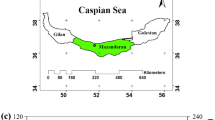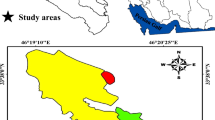Abstract
Biological invasions can alter soil properties within the range of their introduced, leading to impacts on ecosystem services, ecosystem functions, and biodiversity. To better understand the impacts of biological invasions on soil, we compared topsoil physiochemical properties at sites with invasive alien tree species (Prosopis juliflora), native tree species (Prosopis cineraria, Acacia tortilis, and Acacia ehrenbergiana), and mixed tree species in Hormozgan Province of Iran in May 2018. In this study, we collected 40 soil samples at a depth of 10 cm under single tree species, including P. juliflora, P. cineraria, A. tortilis, and A. ehrenbergiana, as well as under mixed tree species. The results showed that organic matter, moisture, potassium, calcium, nitrogen, and magnesium in topsoil at sites with A. tortilis and A. ehrenbergiana growing in combination with P. cineraria were higher than that at sites where P. juliflora was present (P<0.05). Sodium at sites with A. tortilis and A. ehrenbergiana growing in combination with P. cineraria and P. juliflora was lower as compared to that at sites with just A. tortilis and A. ehrenbergiana. Electrical conductivity was lower at sites with A. tortilis and A. ehrenbergiana growing in combination with P. cineraria, and it was higher at sites with mixed Acacia and P. juliflora trees. Based on the generally more positive effect of native Acacia and P. cineraria on topsoil physiochemical properties as compared to the P. julifora, afforestation with native tree species is preferable for soil restoration. In addition, due to the negative effects of P. julifora on soil properties, P. julifora spread should be better managed.
Similar content being viewed by others
References
Abbasi T, Abbasi S A. (2011). Sources of pollution in rooftop rainwater harvesting systems and their control. Critical Reviews in Environmental Science and Technology, 41: 2097–2167.
Al-Abdali S S, Al-Dhuhli A S, Al-Reasi H A. (2019). Preliminary investigations of allelopathic effects and herbicide-based eradication of mesquite (Prosopisjuliflora). Sultan Qaboos University Journal for Science, 24(1): 11–17.
Bavaraja P K, Sharma S D, Badrinath M S, et al. (2007). Prosopis juliflora-An efficient tree species for reclamation of salt affected soils. Karnataka Journal of Agricultural Sciences, 20(4): 727–731.
Bijani A. 2020. Investigation of allelopathic effects of native and alien Prosopis on some soil chemical content and characteristics of Accacia tortilis and Acacia ehrenbergiana in Hormozgan Province (Sirick city). MSc Thesis. Bandar Abbas: Islamic Azad University.
Black C A. 1965. Methods of Soil Analysis. Madison: American Soil Society of Agronomy Press.
Blackburn T M, Essl F, Evans T, et al. (2014). A unified classification of alien species based on the magnitude of their environmental impacts. PLoS Biology, 12(5): e1001850, doi: https://doi.org/10.1371/journal.pbio.1001850.
Chou C H. (2010). Roles of allelopathy in plant biodiversity and sustainable agriculture. Critical Reviews in Plant Sciences, 18(5): 609–636.
Dzikiti S, Schachtschneider K, Naiken V, et al. (2013). Water relations and the effects of clearing invasive Prosopis trees on groundwater in an arid environment in the Northern Cape, South Africa. Journal of Arid Environments, 90: 103–113.
Dzikiti S, Ntshidi Z, Le Maitre D C, et al. (2017). Assessing water use by Prosopis invasions and Vachellia karroo trees: Implications for groundwater recovery following alien plant removal in an arid catchment in South Africa. Forest Ecology and Management, 398: 153–163.
Edrisi S A, El-Keblawy A, Abhilash P C. (2020). Sustainability analysis of Prosopis juliflora (Sw.) DC based restoration of degraded land in North India. Land, 9(2): 59, doi: https://doi.org/10.3390/land9020059.
El-Keblawy A, Al-Rawai A. (2007). Impacts of the invasive exotic Prosopis juliflora (Sw.) D.C. on the native flora and soils of the UAE. Plant Ecology, 190(1): 23–35.
El-Keblawy A, Abdelfatah M. 2014. Impact of native and invasive exotic Prosopis congeners on soil properties and associated flora in the arid United Arab Emirates. Journal of Arid Environments, 100–101: 1–8.
El-Shabasy A. (2017). Study on allelopathic effect of Prosopis juliflora on mineral content of Acacia ehrenbergiana in Farasan Islands, KSA. Journal of Medicinal Plants Studies, 5: 130–134.
Fadoul M S, Elamin M A. (2016). Impact of water harvesting techniques on growth of some indigenous tree species in Jebel Awila Locality, Sudan. Global Journal of Science Frontier Research: (D) Agriculture and Veterinary, 16(3): 42–53.
Garg V K, Singh B. (2003). Macronutrient dynamics and use efficiency in three species of short rotation forestry developed on sodic soils in North India. Journal of Tropical Forest Science, 15(2): 289–302.
Gioria M, Osborne B A. (2014). Resource competition in plant invasions: emerging patterns and research needs. Frontiers in Plant Science, 5: 501, doi: https://doi.org/10.3389/fpls.2014.00501.
Goel U, Saxena D B, Kumar B. (1989). Comparative study of allelopathy as exhibited by Prosopis Juliflora swartz and Prosopis cineraria (L) druce. Journal of Chemical Ecology, 15: 591–600.
Goel V L, Behl H M. (1999). Screening of Prosopis germplasm for afforestation of degraded soil sites: performance, leaf nutrient status and influence on soil properties. Journal of Sustainable Forestry, 8(2): 1–13.
Guevara A, Giordano C V, Aranibar J, et al. (2010). Phenotypic plasticity of the coarse root system of Prosopis flexuosa, a phreatophyte tree, in the Monte Desert (Argentina). Plant Soil, 330: 447–464.
Hejda M, Pyšek P, Jarošík V. (2009). Impact of invasive plants on the species richness, diversity and composition of invaded communities. Journal of Ecology, 97(3): 393–403.
Inderjit, Seastedt T R, Callaway R M, et al. (2008). Allelopathy and plant invasions: traditional, congeneric, and biogeographical approaches. Biological Invasions, 10(6): 875–890.
Kahi C H, Ngugi R K, Mureithi S M, et al. (2009). The canopy effects of Prosopis juliflora (DC.) and Acacia tortilis (Hayne) trees on herbaceous plants species and soil physico-chemical properties in Njemps Flats, Kenya. Tropical and Subtropical Agroecosystems, 10(3): 441–449.
Kaur R, Gonzales W L, Llambi L D, et al. (2012). Community impacts of Prosopis juliflora invasion: biogeographic and congeneric comparisons. PLoS ONE, 7(9): e44966, doi: https://doi.org/10.1371/journal.pone.0044966.
Kazemi S H, Hojjati M, Falah A, et al. (2015). Effect of forest management on soil physical and chemical properties of Khalil-Mahale forest. Journal of Forest Research and Development, 1(2): 167–180.
Linders T E, Bekele K, Schaffner U, et al. (2020). The impact of invasive species on social-ecological systems: Relating supply and use of selected provisioning ecosystem services. Ecosystem Services, 41: 101055, doi: https://doi.org/10.1016/j.ecoser.2019.101055.
Moradi M, Imani F, Naji H R, et al. 2013. Variation in soil carbon stock and nutrient content in sand dunes after afforestation by Prosopis juliflora in the Khuzestan province (Iran). iForest-Biogeosciences and Forestry, 10(3): 585–589.
Mosbah M, Tounekti T, Khemira H. (2018). Invasive character of Prosopis juliflora is facilitated by its allelopathy and a wide mutualistic interaction with soil microorganisms. Journal of Biological Sciences, 18: 115–123.
Nahali M H. (2000). Ecological evaluation of Prosopis juliflora and its potential for composting in Hormozgan province. Agricultural Economics and Development, 8(31): 305–323.
Nascimento C E D S, da Silva C A D, Leal I R, et al. (2020). Seed germination and early seedling survival of the invasive species Prosopis juliflora (Fabaceae) depend on habitat and seed dispersal mode in the Caatinga dry forest. Peer Journal, 8: e9607, doi: https://doi.org/10.7717/peerj.9607.
Pasiecznik N M, Harris P J C, Smith S J. 2004. Identifying Tropical Prosopis Species: A Field Guide. Conventry: HDRA Publishing.
Reinhart K O, Callaway R M. (2006). Soil biota and invasive plants. New Phytology, 170: 445–457.
Schachtschneider K, February E C. (2013). Impact of Prosopis invasion on a keystone tree species in the Kalahari Desert. Plant Ecology, 214(4): 597–605.
Shackleton R T, Le Maitre D C, Pasiecznik N M, et al. (2014). Prosopis: a global assessment of the biogeography, benefits, impacts and management of one of the world’s worst woody invasive plant taxa. AoB Plants, 6: plu027, doi: https://doi.org/10.1093/aobpla/plu027.
Shackleton R T, Le Maitre D C, van Wilgen B W, et al. (2015). The impact of invasive alien Prosopis species (mesquite) on native plants in different environments in South Africa. South African Journal of Botany, 97: 25–31.
Shackleton R T, Shackleton C M, Kull C A. (2019). The role of invasive alien species in shaping local livelihoods and human well-being: A review. Journal of Environmental Management, 229: 145–157.
Sharifian A, Niknahad-Gharmakher H, Foladizada M, et al. 2022. Socio-ecological evidence highlights that native Prosopis species are better for arid land restoration than non-native ones. Restoration Ecology, doi: https://doi.org/10.1111/rec.13756.
Shiferaw H, Bewket W, Alamirew T, et al. (2019). Implications of land use/land cover dynamics and Prosopis invasion on ecosystem service values in Afar Region, Ethiopia. Science of the Total Environment, 675: 354–366.
Shitanda D, Mukonyi K, Kagiri M, et al. (2013). Properties of Prosopis Juliflora and its potential uses in asal areas of Kenya. Journal of Agriculture, Science and Technology, 15(1): 15–27.
Sintayehu D W, Dalle G, Bobasa A F. (2020). Impacts of climate change on current and future invasion of Prosopis juliflora in Ethiopia: environmental and socio-economic implications. Heliyon, 6(8): e04596, doi: https://doi.org/10.1016/j.heliyon.2020.e04596.
Smith J L, Doran J W. 1996. Measurement and use of pH and electrical conductivity for soil quality analysis. In: Methods for Assessing Soil Quality. Soil Science Society American. Madison, USA.
Thomas G W. 1982. Exchangeable cations. In: Page A L, Miller R H, Keeney D R. Methods of Soil Analysis. Part, 2. Chemical and Microbiological Properties. Madison: American Society of Agronomy.
Vila M, Espinar J L, Hejda M, et al. (2011). Ecological impacts of invasive alien plants: a meta-analysis of their effects on species, communities and ecosystems. Ecology Letters, 14(7): 702–708.
Weidenhamer J D, Callaway R M. (2010). Direct and indirect effects of invasive plants on soil chemistry and ecosystem function. Journal of Chemical Ecology, 36: 59–69.
Zhang X X, Liu Z W, Tian N, et al. (2015). Allelopathic effects of decomposed leaf litter from intercropped trees on rape. Turkish Journal of Agriculture and Forestry, 39: 898–908.
Acknowledgements
The authors appreciate the Bandar Abbas Branch, Islamic Azad University and Hormozgan Agricultural and Natural Resources Research and Education Center, Agricultural Research, Education and Extension Organization (AREEO), Iran.
Author information
Authors and Affiliations
Corresponding author
Rights and permissions
About this article
Cite this article
Moslehi Jouybari, M., Bijani, A., Parvaresh, H. et al. Effects of native and invasive Prosopis species on topsoil physiochemical properties in an arid riparian forest of Hormozgan Province, Iran. J. Arid Land 14, 1099–1108 (2022). https://doi.org/10.1007/s40333-022-0104-y
Received:
Revised:
Accepted:
Published:
Issue Date:
DOI: https://doi.org/10.1007/s40333-022-0104-y




